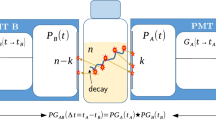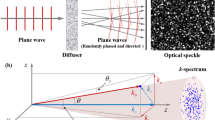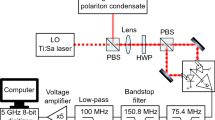Abstract
DURING the past decade photomultiplier-tube technology and signal processing using integrated circuits have progressed to the point at which the analysis of fluctuating light signals can now be carried out digitally, in real time, with accuracy close to the theoretical limit. These ‘photon correlation’ techniques have so far found their main application in laser light-scattering spectroscopy1 and laser doppler velocimetry2. The techniques need not, however, be limited to applications involving lasers and can be used for the analysis of fluctuating optical signals of any origin (provided the fluctuation time is ≥ 10−8 s). Here we report a preliminary study of the statistical and temporal correlation properties of stellar scintillation, taking advantage of the fast response time and high sensitivity of equipment now standard for laser light-scattering applications.
This is a preview of subscription content, access via your institution
Access options
Subscribe to this journal
Receive 51 print issues and online access
$199.00 per year
only $3.90 per issue
Buy this article
- Purchase on Springer Link
- Instant access to full article PDF
Prices may be subject to local taxes which are calculated during checkout
Similar content being viewed by others
References
Photon Correlation and Light Beating Spectroscopy (edit. by Cummins, H. Z., and Pike, E. R.), (Plenum, London and New York, 1974).
Abbiss, J. B., Chubb, T. W., and Pike, E. R., Opt. Laser Technol., 6, 249–261 (1974).
Young, A. T., Appl. Optics, 8, 869–885 (1969).
Vernin, J., and Roddier, F., J. opt. Soc. Am., 63, 270–273 (1973).
Singleton, D. G., J. atmos. terr. Phys., 32, 187–208 (1970).
Rocca, A., Roddier, F., and Vernin, J., J. opt. Soc. Am., 64, 1000–1004 (1974).
Ochs, G. R., Clifford, S. F., Lawrence, R. S., and Wang, T-h, Natn. Oceanic atmos. Admin. Tech. Rep., ERL297–WPL30 (1974).
Labeyrie, A., Nouv. Rev. d'Opt., 5, 141 (1975).
Jakeman, E., Oliver, C. J., Pike, E. R., and Pusey, P. N., J. Phys. A., 5, L93–96 (1972).
Minnaert, M., Nature, 165, 663–664 (1950).
See for example Burke, J. J., J. opt. Soc. Am., 60, 1262–1264 (1970).
Prokhorov, A. M., Bunkin, F. V., Gochelashvily, K. S., and Shishov, V. I., Proc. IEEE, 63, 790–811 (1975).
Bramley, E. N., and Young, M., Proc. IEE, Lond., 114, 553–556 (1967).
Taylor, L. S., and Infosino, C. J., J. opt. Soc. Am., 65, 78–84 (1975).
Jakeman, E., and McWhirter, J. G., J. Phys. A., 9, 785–797 (1976).
Mikesell, A. H., Hoag, A. A., and Hall, J. S., J. opt. Soc. Am., 41, 689–695 (1951).
Author information
Authors and Affiliations
Rights and permissions
About this article
Cite this article
JAKEMAN, E., PIKE, E. & PUSEY, P. Photon correlation study of stellar scintillation. Nature 263, 215–217 (1976). https://doi.org/10.1038/263215a0
Received:
Accepted:
Published:
Issue Date:
DOI: https://doi.org/10.1038/263215a0
This article is cited by
-
Dynamic laser speckles and their application to velocity measurements of the diffuse object
Applied Physics (1981)
-
Laser Speckles-A Bibliography: 1976-1978
Journal of Optics (1977)
Comments
By submitting a comment you agree to abide by our Terms and Community Guidelines. If you find something abusive or that does not comply with our terms or guidelines please flag it as inappropriate.



